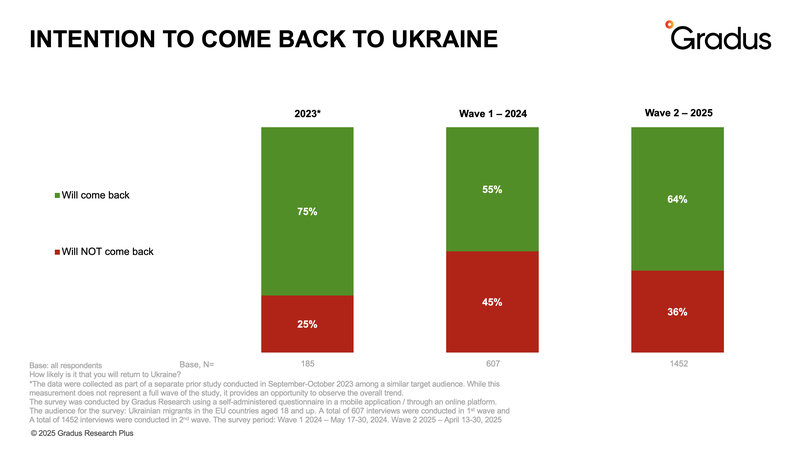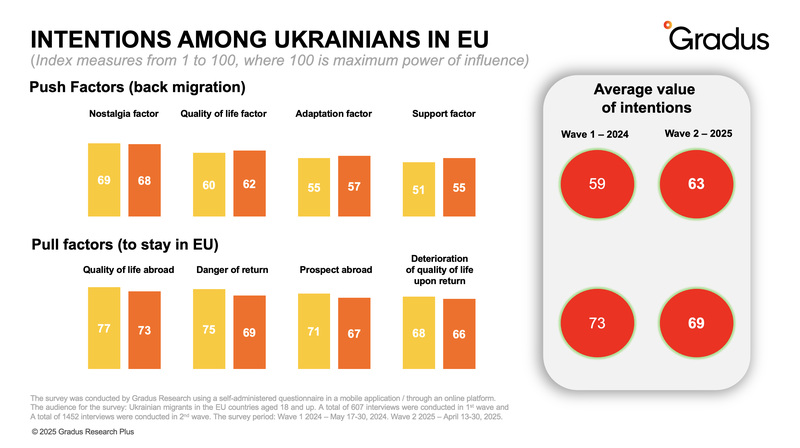Return or Stay? How Ukrainian Migrants’ Sentiments in the EU Are Changing

Are Ukrainians abroad ready to return home? Or are they becoming increasingly rooted in EU countries? In April 2025, Gradus Research conducted the second wave of its study on the factors influencing Ukrainians’ decisions to either return from the European Union or remain there. As with the first wave, the results were presented at the Ukraine Recovery Conference (URC) 2025.
How many Ukrainian citizens plan to return, and when?
In 2025, the share of those who want to return to Ukraine increased to 64%, compared to 55% last year. However, this figure is still lower than in 2023 (75%). This suggests not so much an unequivocal rise in readiness to return as the persistence of an emotional desire to come back — despite the fact that rational restraining factors still prevail.

What exactly drives these decisions?
Last year, Gradus Research first analyzed the factors influencing Ukrainians abroad in deciding whether to return home or stay in their host countries. All factors were grouped into two broad categories: those that stimulate return (push factors) and those that hinder it (pull factors).

What motivates return? The main drivers are emotional nostalgia for Ukraine, the perception of a higher quality of life at home, difficulties in adapting to a new environment, and the expectation of support in a familiar social context. Emotional attachment and the belief that life in Ukraine could be better are the strongest influences. People are not only homesick — they are also tired of the strain of adaptation.
Why do they stay? The decision to remain is most often linked to a sense of greater stability abroad, including a higher quality of life, a safer environment, broader opportunities for themselves and their children, and concerns about the difficult conditions they may face upon return.
Compared to the previous wave, we see an increase in the strength of motivating factors and a slight decrease in restraining ones. This reflects a motivational conflict — people want to return, but do not see the right conditions. The overall index has decreased, indicating the EU’s strengthening position as a place for long-term residence.
It is also important to note that perceptions of return possibilities and the timelines for such decisions are influenced by the information environment. During the April 2025 survey period, there were renewed signals about possible negotiations and several public pro-Ukrainian statements by the U.S. president, which may have temporarily reinforced expectations for positive change.
“This is already the second wave of our study on factors influencing Ukrainians’ return from the EU. We continue to monitor migrants’ sentiments, as this is a complex and dynamic issue that requires regular analysis in constantly changing conditions — both in Ukraine and abroad. In particular, the intention to return fluctuates depending on the context. The emotional desire to come back is there, but restraining factors still prevail. In 2025, the main reason for not returning was a higher quality of life abroad, whereas last year, the leading deterrent was security. Studies like this help us better understand what shapes return decisions and how these factors evolve over time,” said Evgeniya Blyznyuk, sociologist, CEO & founder of Gradus Research.
The survey was conducted by Gradus Research via self-administered questionnaires in the Gradus mobile app. Target audience: Ukrainian migrants in EU countries aged 18 and older. Fieldwork period: April 13–30, 2025. Sample size: 1452 respondents.
Other reports
-
 Wartime survey of Ukrainian society / thirteenth waveDecember 2025Ukrainians Seek a Sustainable Peace and Do Not Believe in a Quick End to the War
Wartime survey of Ukrainian society / thirteenth waveDecember 2025Ukrainians Seek a Sustainable Peace and Do Not Believe in a Quick End to the War -
 How Ukrainians feel in the 4th year of war and how they copeDecember 2025Special survey for the 18' People Management Conference
How Ukrainians feel in the 4th year of war and how they copeDecember 2025Special survey for the 18' People Management Conference -
 Consumer pragmatism: how war has changed our consumption habitsDecember 2025Special survey in partnership with Vogue Ukraine
Consumer pragmatism: how war has changed our consumption habitsDecember 2025Special survey in partnership with Vogue Ukraine -
 In a new light: Gradus presented its new identity and positioningDecember 2025The rebranding included an updated identity and a new positioning , created in collaboration with Netpeak Agency
In a new light: Gradus presented its new identity and positioningDecember 2025The rebranding included an updated identity and a new positioning , created in collaboration with Netpeak Agency





